
We’ve all heard it: White goes first, White wins more often. But is that just chess folklore, or is there something real behind the hype? Let’s crack open the data and find out whether that first-move edge is a game-changer—or just an old tale whispered in chess clubs.
We used a large Kaggle dataset of chess games to break this down by Elo rating, win percentages, and pairings of players. Spoiler: the numbers speak for themselves.
Quick Chess 101: Elo and the Basics
Before we dive in, a quick refresher.
Elo rating is how chess measures skill. The higher your Elo, the better you are. Win against someone stronger? Your Elo jumps. Lose to someone weaker? It drops.
Also: White always moves first. That small detail is where the whole “first-move advantage” conversation begins.
With that in mind, let’s see what the numbers reveal.
Do White Players Just Have Better Elo? Not Really.
Let’s begin with a reality check: are White players necessarily higher-rated? Maybe the advantage isn’t color-based, but skill-based.
We compared the Elo rating distributions for both White and Black players using violin plots—and the result? They are nearly identical. The plots show that most players, regardless of color, cluster around 1750 Elo, indicating that the skill levels of players in both groups are fairly even. So, if White is winning more, it’s not because White players are inherently superior.
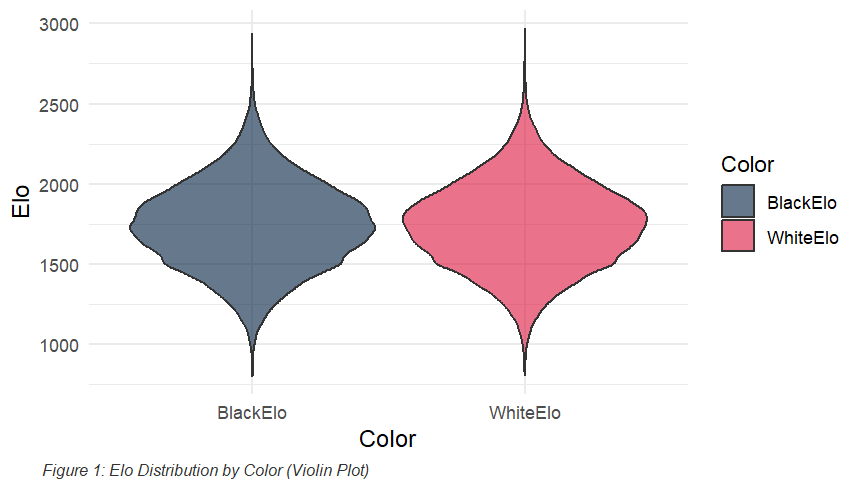
Head-to-Head: Who Faces Who?
Now, let’s throw some color into the mix—literally. We pictured head-to-head encounters in a heatmap, comparing the Elo ratings of White and Black players. The X and Y axes are the Elo ratings of White and Black, respectively, with the darkest points along the diagonal being matchups between similarly rated players. The farther you are from this diagonal, the lighter the colors become, indicating less common matchups.
The point: If White is preferred, it’s not due to biased matchups. The distribution of games is largely even, so any White preference likely stems from the first-move advantage rather than a difference in skill between the players.
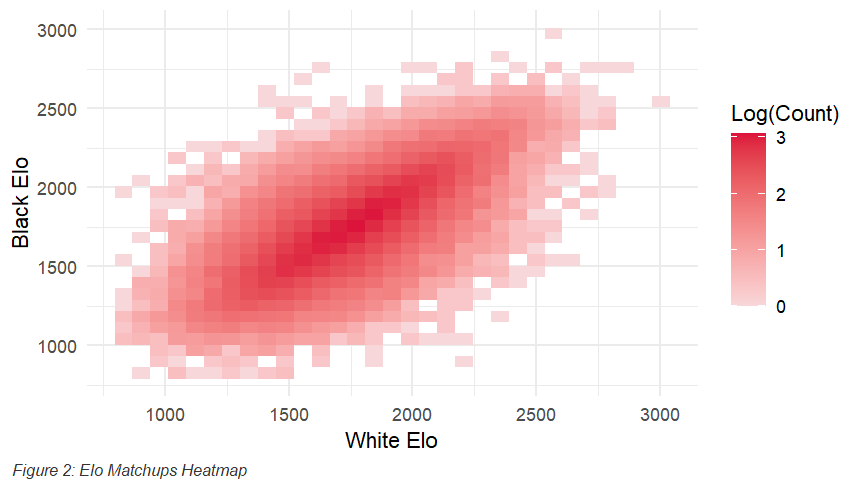
How Elo Differences Shift the Balance of Power
It’s one thing to compare players of equal skill, but what happens when one side is clearly stronger? We charted win rates by Elo difference—how much higher one player’s Elo was than the other.
The results? Clear as a bishop’s diagonal. When White has a higher Elo, their win rate spikes dramatically. But when Black has the upper hand, the climb is more modest. In short: both sides benefit from Elo superiority, but White turns it into a more pronounced advantage. The graph shows that Elo is a strong predictor of outcomes—the higher a player’s rating, the more likely they are to win. The red (White) and black (Black) curves mirror each other, showing how win rates flip with Elo advantage.
But here’s the twist:
If White has an edge in high-level games between equally rated players, it’s likely not due to Elo alone. That advantage more likely comes from factors like first-move initiative or deeper preparation.
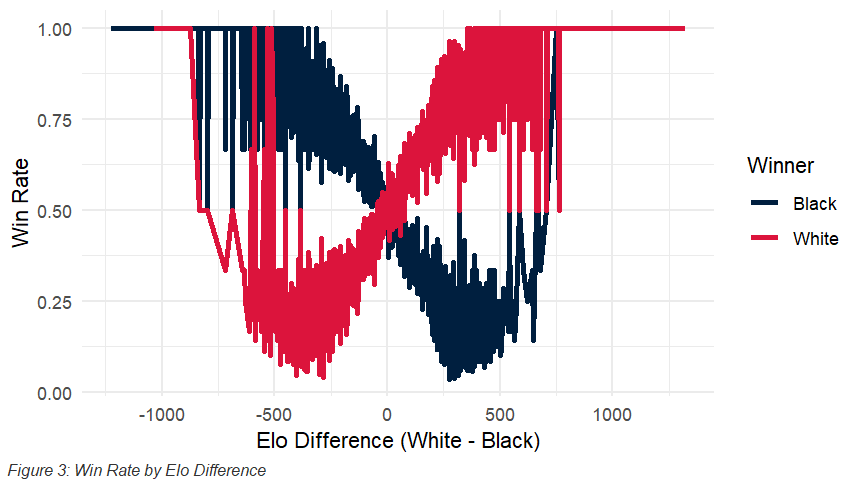
Skill Tiers Don’t Lie: Win Rates by Player Level
Then we slice the data into chess tiers: Beginner, Intermediate, Club, Expert, and Master. It’s like the Hogwarts houses of chess skill.
Beginners? Pretty even. But from Intermediate and beyond, White starts to edge ahead—and never looks back. In the Master tier, the win rate gap becomes massive: White nears a perfect score, while Black hovers just above 0.6. That’s not just a gap—it’s a gulf.
And if you glance at the figures below, you’ll see the story play out in two ways. One chart shows that win rates stay neck-and-neck until the final tier, where White rockets upward. The other? A beautiful slope of imbalance—White’s line climbs steadily, while Black’s dips. The message is clear: the higher the level, the brighter White shines. First-move advantage? It ages like a fine wine—or maybe just a really smug bishop.
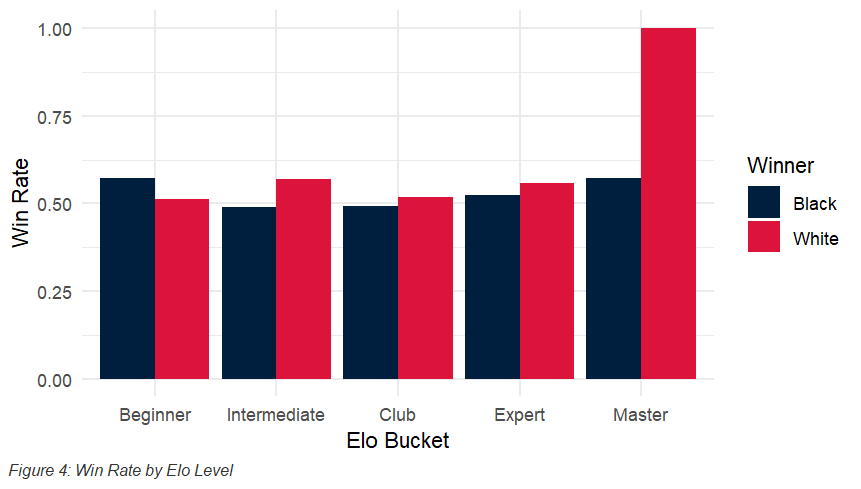
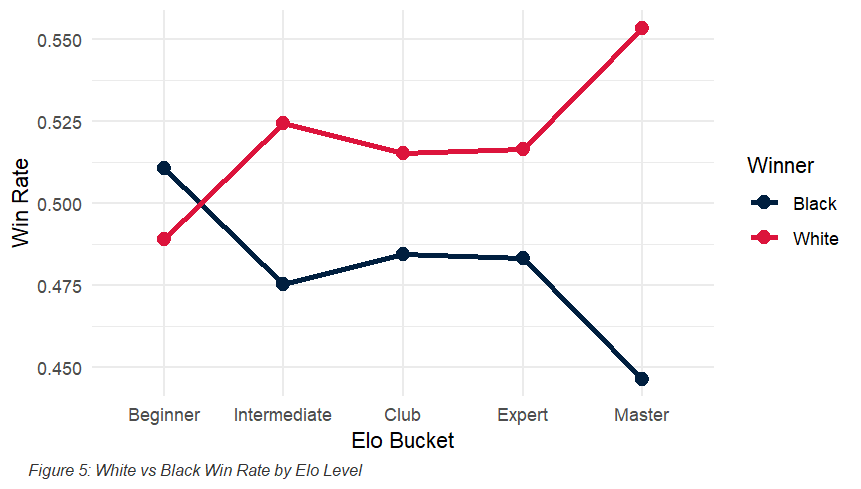
So… Why Does White Win More?
The figures show that it’s not due to higher Elo, nor due to weaker opponents for White to play against.
So what is the explanation?
The best explanation is the advantage that White gets from playing first.
White can set the tone, direct the opening, and force Black to react. At higher levels of play, that tempo matters. Old masters learn how to capitalize on that tiny lead as permanent positional or tactical advantages.
Preparation is another factor to consider. High-level player prepare individual opening lines, since White always has the initiative, they can prepare for individual setups. That is, White’s not simply reacting— they’re setting direction from move one.
Conclusion: First Move, Final Word
So, is White’s first move a secret ace or just superstition? The data says: very much so.
At lower levels, the difference is negligible — almost nothing. But as players improve, White’s edge becomes obvious and substantial. From Elo curves to heatmaps to skill brackets, the message is clear: going first matters.
The first-move advantage will not necessarily win the game, but it at least tips the scales in White’s favor — especially when they can take advantage.

